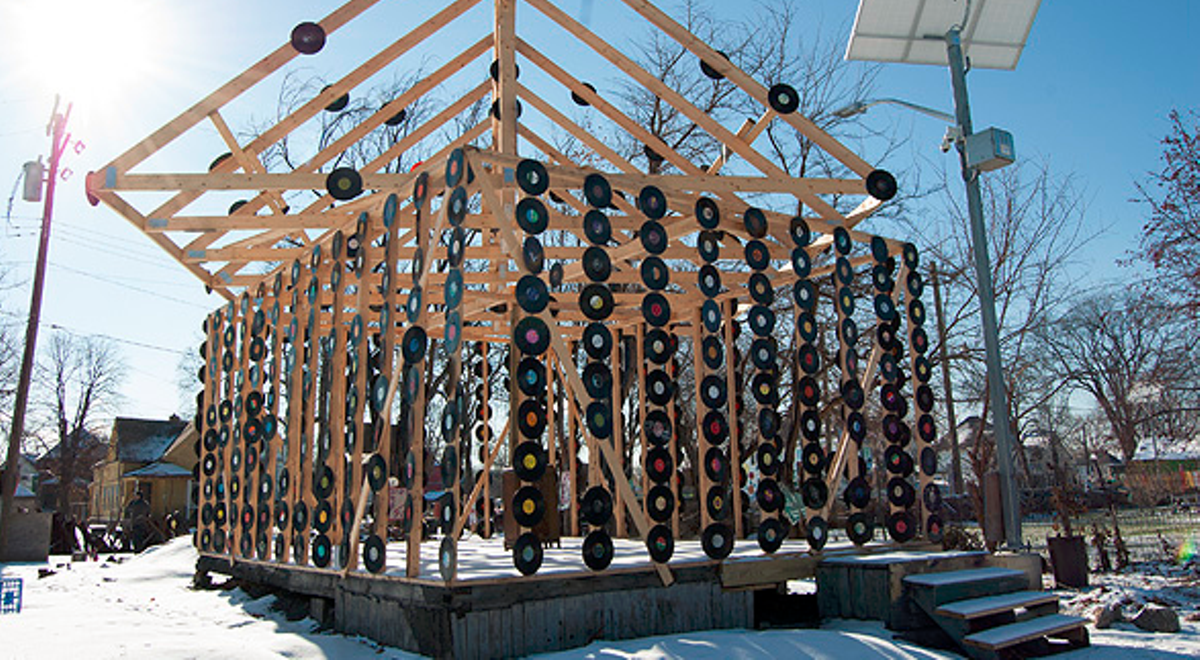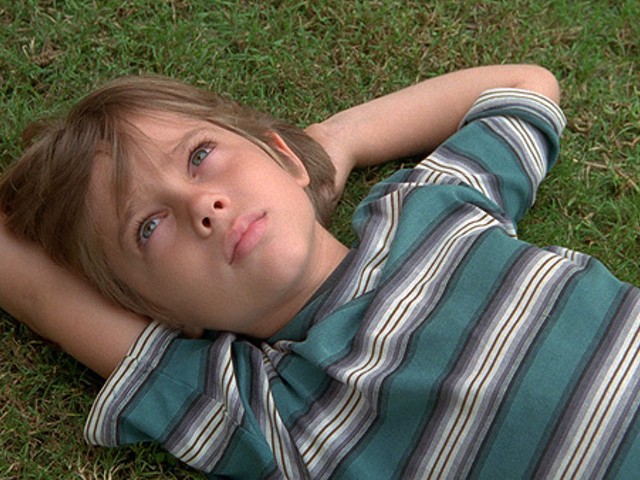There's no doubt about it — 2014 was a dynamic year in Detroit art. Street art was both celebrated and vilified, some galleries closed while others opened, and the city even attracted international attention as entrepreneurs from New York and Berlin eyed its ample abandoned buildings for future arts-related developments. Here's a look back at what we covered:
One of the biggest commotions in art this year in Detroit was caused by developments on a story that originally broke more than four years ago, when a Packard Plant wall, apparently painted by the mysterious, internationally renowned street artist known as Banksy, was immediately snatched up by the 555 Gallery. In March, the 555 announced it was looking to sell the painting, reigniting debates regarding the ownership of street art. Throwing a wrench into the whole thing, two local artists claimed that they were, in fact, the creators of the painting. In August, Fernando Palazuelo, the Peruvian developer who recently bought the long-abandoned Packard, revealed that he wanted Detroit's 555 Gallery to return the painting to the site, but no developments have surfaced since.
Street art was front and center in much of Detroit's art chatter this year. We cheered the efforts of groups like the Detroit Beautification Project and the Grand River Creative Corridor in transforming Detroit's empty walls into vibrant murals in recent years, and took a look at American-themed murals for our Fourth of July issue. However, not everyone was pleased with the explosion of street art in Detroit. Artists like Sintex took issue with the Detroit Beautification Project's propensity to hire acclaimed artists from places like Los Angeles instead of locals and painted over them. Mayor Mike Duggan launched a brief crackdown on street art in the fall and issued close to $8,000 in fines, but backpedaled after it caused an uproar. Perhaps most amusingly was when Quicken Loans' head honcho Dan Gilbert waged a veritable witch-hunt against "three fancy ladies" who vandalized one of his buildings.
In April, the Detroit Institute of Art's once-controversial Detroit Industries murals painted by Diego Rivera were designated as a national landmark, a distinction that came as a surprise to DIA-director Graham Beal. By sheer coincidence, the national landmark designation neatly coincides with a long-planned exhibit detailing the time the Mexican muralist Rivera spent in Detroit working on the murals that will debut in 2015.
Speaking of the DIA, the museum came under fire later in the year when it was revealed that its top execs quietly got bonuses while the museum was campaigning for a tri-county millage for financial support several years ago. Though our own Jack Lessenberry admitted both DIA executives are still not overpaid for the standards of the industry, he concluded simply that "it doesn't look good." We offered a defense of world-class compensation for the staff of the world-class museum.
In May, local art prankster (and Dirty Show impresario) Jerry Vile continued to target the role of art in Detroit's bankruptcy by sticking more than 100 plastic lawn flamingos painted like vultures into the DIA's front lawn — a commentary on the threats to appease "creditor vultures" by selling off the museum's art. However, the threats were put to rest when the DIA was spun into its own nonprofit entity, Detroit Institute of Arts, Inc., as part of the city's bankruptcy exit plan this month.
In September, ArtPrize — the so-called "American Idol of art" that was launched in 2009 by Amway heir Rick DeVos — continued for its sixth year in Grand Rapids. Initially looking to skewer the event, we sought out Vile to offer what we thought would be a scathing critique; he provided a thoughtful defense of the spectacle instead. (Vile was one of numerous Detroit-based artists to show there, though his entry — a model subdivision home created out of cardboard and tarps — didn't place.)
That same month, Detroit's tight-knit arts community took a blow when artist Gilda Snowden died in September, the news coming from a post on her Facebook account by her family. A College for Creative Studies professor, Snowden was a regular fixture at art events, whether with her old Cass Corridor cohort or supporting her students' work. She was 60.
Also in September, we spoke with Tyree Guyton, whose neighborhood-sized art installation, the Heidelberg Project, has been the target of a rash of arsons for the past year. Guyton debuted his show Spirit, his first solo show in Detroit in years, at the Inner State Gallery the next month, defiantly repurposing art that was damaged in the fire by painting it with grinning faces. Meanwhile, the Heidelberg Project set up solar-powered security cameras in an attempt to capture the firebug in the act, but so far no leads have been produced — though the cameras did manage to catch a video of one arsonist setting the "Taxi House" ablaze in November, apparently singing himself in the process. The Heidelberg Project erected a new "House of Soul" in November.
We also had the chance to speak with Nadya Tolokonnikova and Masha Alekhina that month, better known as the public faces of the Russian protest group Pussy Riot, before their appearance at the Michigan Theater in Ann Arbor as part of the University of Michigan's Penny Stamps Speaker Series. Tolokonnikova and Alekhina spoke about their current work in creating MediaZona, a new outlet that will cover the prison system, serving time for performing an anti-Putin "Punk Prayer" in a Moscow cathedral, and about using punk rock and art as a form of social protest.
Speaking of punk and art, Detroit's Niagara, the queen of both realms, had a good year. Back in March, supermodel Kate Moss served as editor for British Vogue, and for her first assignment she styled a model after Niagara, faithfully re-creating photos of Niagara from her time in Detroit's punk scene. Then in November, Niagara got more national attention when Kid Rock put a painting of hers on his latest album cover. In other Niagara news, her work with the band Destroy All Monsters was displayed at What Nerve! Alternative Figures in American Art at the Rhode Island School of Design.
We have to admit we were disappointed to hear the University of Michigan's decision to quietly shut down its Work • Detroit Gallery in April. The gallery has occupied its space on Woodward Avenue and Martin Luther King Jr., Boulevard, hosting a variety of shows, including a celebration of the zine. Other galleries to close included the Butcher's Daughter, a Ferndale gallery that enjoyed a very brief stint in Midtown before up and moving to New York.
Fortunately, it wasn't all gallery closings this year. In the summer, Steve Panton opened the 9338 Campau Gallery in Hamtramck, a new incarnation of his previous 2739 Edwin Gallery. The UFO Factory, an arty bar and performance venue, opened in the fall in Corktown, and most recently, Birmingham's David Klein Gallery announced plans to open a Detroit location in 2015.
In the summer, 333 Midland opened in Highland Park, a sprawling former auto factory that now serves as art studios and galleries, co-founded by New Zealand artist Robert Onnes. Similarly, Berlin entrepreneur Dimitri Hegemann visited Detroit to check out the old Fisher Body 21 plant with aims to transform it into, in part, an art space and techno nightclub like he did with his Tresor club in Germany. Most recently, New York's Galapagos Art Space announced that it was moving to Detroit, in search of cheaper rent.
In other news, 2014 looks to be another year in which Detroit did not get its long-promised RoboCop statue, though people close to the project teased developments early in the year. Well, there's always next year.
Have any Detroit art tips for 2015? Send them to [email protected].







